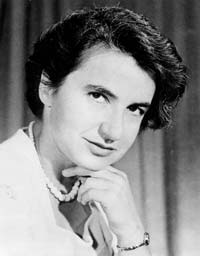
| Born: July 25, 1920 in Notting Hill, London |
| Died: Apr 16, 1958 (at age 37) in Chelsea, London |
| Nationality: British |
| Field: X-ray crystallography |
| Famous For: Fine structure of coal and graphite, Structure of DNA, structure of viruses |
By 1952 a lot was known about DNA. However, little about its molecules and physical structure was understood. The double helical structure of DNA that we are familiar with today was not discovered until 1953 by Rosalind Elsie Franklin.
Early Life
Rosalind Franklin was born in 1920, in London, England. She had a family which was very involved in social and public works. Her father had a dream of becoming a scientist but WWI cut short his ambitions and he became a teacher in a college in England instead. Rosalind was very intelligent from a young age.
By the age of 15 she already knew that she wanted to become a scientist. She was discouraged by her father since he thought that it was very difficult for women to be recognized as scientists at that time. In spite of this, she went on with her education at St. Paul Girls’ School. This was one of the very few schools that offered chemistry and physics for girls at that time. Rosalinda then joined Cambridge University in 1938 where she studied chemistry.
Career Life
Franklin worked on wartime problems after graduating with a Bachelors degree in 1941. She studied the nature of coal and charcoal and their use. She made five publications on these subjects before her 26th birthday. She later graduated from Cambridge University with a PhD in 1945, just after WWII was over.
She went on to work for John Randall at the King’s College in 1951 as his research associate. A chemist by profession, Rosalind established herself as one of the world’s experts in graphite structure as well as carbon compounds prior to her move to London. She made discoveries that the DNA could crystallize into two forms while with Maurice Wilkins at King’s College in London.
Contributions and Achievements
Rosalind made tremendous contributions regarding the solution structure of DNA. She discovered that two forms of DNA existed; form A and form B, and that these two molecules existed in different conditions. She laid the basis for quantitative studies of diffraction patterns and demonstrated the double helix of the DNA in an X-ray experiment. She made excellent X-ray photographs that she had obtained from her systematic work and painstakingly and explained their implications as well.
Death
While she was on a professional visit to the United States she experienced episodes of pain that were later found to be ovarian cancer. She continued to work for two years. She underwent three operations and chemotherapy before a 10 month remission. She died at the age of 37 in 1958.